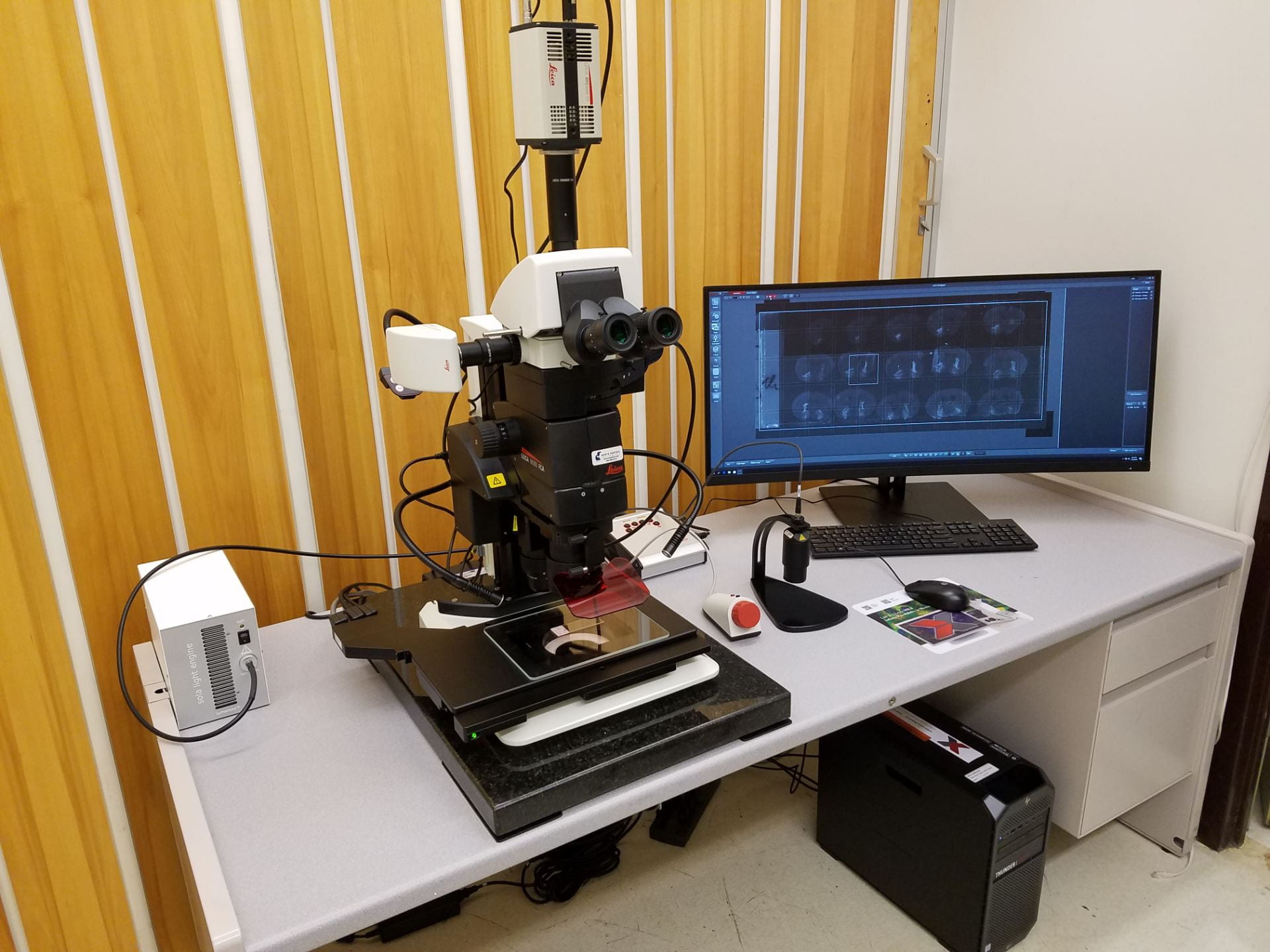
Leica Thunder Macroscope
Installed in November of 2019, the Leica Thunder Model Organism Microscope is a fluorescent motorized stereomicroscope for imaging color or black and white images and movies of large thick samples. Built upon the fully motorized Leica MC205FA stereomicroscope, it incorporates Leica’s proprietary Computational Clearing algorithm to produce deep Z stack images with near-confocal clarity while utilizing the speed of a widefield camera system. Equipped with 4 fluorescence filter wheels and 3 brightfield modalities utilizing Leica
Triple Beam technology, multichannel images can be acquired with an ultra-sensitive sCMOS camera. Alternatively, color images can be acquired with a second dedicated 5 megapixel color CCD camera. With an XY interface range of 160 X 110 mm, as many as 8 microscope slides can be imaged automatically in either fluorescent or brightfield color modes. The large flat transparent stage also easily accommodates round or square petris and all types of multiwell plates. In addition, an incorporated gooseneck lamp allows for imaging of reflected light for opaque samples and small animals. Z drive is fully automated, and has a 420 mm travel range with a resolution of 1 µm. The system incorporates two objectives that together provide a magnification range from 7.8X to over 600X. The 5X macro lens provides parallax-free imaging with a working distance of 19mm.
This instrument is ideal for all types of model organism analyses; including live screening for fluorescent protein transformants, scanning and recording brain slices, tile scanning entire mouse embryo slices at high resolution, rapidly producing highly resolved Z stacks of up to 500 µm, and setting up time lapse experiments at very low light for photosensitive samples.
Leica MC205FA stereo/macroscope. Fully automated Z drive with 420 mm range and 1 µm z-resolution. Manual zoom from 0.78 to 16X. Four position filter turret; 4 coded filter sets. High precision Scanning stage with integrated controller; position resolution <= 5 nm and maximum load capacity of 1.5 kg.
| Light Source | Specifications |
|
Lumencor SOLA SM LED (Fluorescent light source) |
3.5-4W white light output; 350-680 nm wavelength range; 3 mm diameter liquid light guide; 30,000 hour lifetime |
|
TL5000 Ergo |
LED, 65 mm illuminated space; homogenous transmitted |
|
Leica LED5000 SLI Gooseneck |
LED spotlight reflected illumination; 2 goosenecks with 500 mm length; 5600K color temperature |
| Filter | Excitation | Emission |
|
ET DAPI |
AT350/50x nm |
ET460/50m nm |
|
ET GFP |
ET470/40 nm |
ET525/50 nm |
|
ET YFP |
ET500/20 nm |
ET535/30 nm |
|
ET RFP |
ET546/11 nm |
ET605/70 nm |
| Camera | Specifications |
|
DFC9000GT sCMOS monochrome |
4.2 MP sCMOS chip; 2048 X 2048 pixels; 6.5 X 6.5 µm pixel size; quantum efficiency 82% @ 580 nm; dynamic range 1:33000; 540 MHz max clock frequency; 50 fps max speed full frame |
|
Leica DMC4500 color CCD camera |
5 MP CCD sensor; 2560 X 1920 pixels; 3.4 X 3.4 µm pixel size; >900:1 dynamic range; 50 MHz max clock frequency; 9 fps max speed full frame |
LAS X software with the following modules:
| Module | Uses |
|
Navigator |
GUI for point scanning and Tiled images |
|
Assay Editor |
Automatic distribution of ROIs and positions within defined sample carrier for statistical acquisition |
|
Instant Computational Clearing (ICC) |
Instantaneous removal of out of focus background |
|
Small Volume Computational Clearing (SVCC) |
Addition of 3D deconvolved decision mask on ICC, best for thin specimens |
|
Large Volume Computational Clearing (LVCC) |
Addition of 3D deconvolved decision mask on ICC, best for thick specimens |
|
Microlab |
Wizards for Z stacks, timelapse |
|
Dye Finder |
Wizard for multicolor imaging setup |
Applications:
Fluorescent multi-channel imaging; Brightfield, Rottermann contrast and two sided darkfield monochromatic/color imaging; live imaging; tiled imaging; point scanning; multiwell and petri scanning; timelapse; deep imaging; fast acquisition; on the fly deconvolution; adaptive deconvolution.
Output:
.lei, .tiff, .avi, .mov, .mpeg4